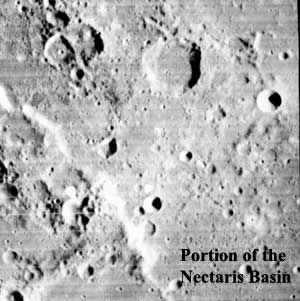The Neohadean Era
3950 to 3900 million years ago
Goldblatt et al. 2010 conclude the division of the Hadean with the not unexpectedly named Neohadean. As with the other two eras, this is divided into two periods. In this case an earlier one called the Acastan, after the Acasta Gneiss, a rock outcrop in the Slave craton in Northwest Territories, Canada, dated at 4.031 to 3.58 billion years old, making it the oldest known intact crustal fragment on Earth, dating back to the original formation of continents. It is, however, in the following Promethean period where cosmic events start happening. MAK110906
Approximately 4100-3950 Ma, orbital instability of the jovians started the Late Heavy Bombardment (LHB). For the next several geons, the Earth and Moon were struck numerous asteroids and meteorites, the largest of which would have vapourised the ocean and killed any pre-existing life. For this reason, Goldblatt et al 2010 named the Late Neohadean period Promethean. In Greek mythology, Zeus vented his fury on Prometheus by bombarding the Earth (Aeschylus, Prometheus Bound tr. P. Vellacott, closing speech):
"The Earth rocks: thunder, echoing from the depth,
roars in answer; fiery lightnings twist and flash. . .
Sky and sea rage indistinguishably,
The cataclysm advances visibly upon me,
sent by Zeus to make afraid."
One scenario (see diagram below) says Jupiter and Saturn (slowly) migrated into a mutual 1:2 resonance which made a formerly stable jovian system chaotically unstable. The chances that Uranus and Neptune would change places with each other would according to similar theories be 50%. This jovian system disruption would cause:
- Jupiter cleaning up the zone of the current asteroid main belt, inner planets being heavily bombarded by asteroids,
- Neptune running straight into the zone of outer solar system icy planets, there wreaking havoc, creating a similar but much more intense bombardment within the jovian system, including of course the jovian icy moons. Neptune captured the former icy planet Triton in a retrograde orbit at that time.

Simulation showing Outer Planets and Kuiper Belt:
a) Before Jupiter/Saturn 2:1 resonance.
b) Scattering of Kuiper Belt objects into the solar system after the orbital shift of Neptune.
c) After ejection of Kuiper Belt bodies by Jupiter.
Planets shown: Jupiter (green circle), Saturn (orange circle), Uranus (light blue circle) and Neptune (dark blue circle).
Graphic by Mark Booth - from Wikipedia, based on Gomes et al., 2005 |
The LHB declines inversely exponentially, so that by ca 3800 Ma the impact levels reaches "normal". rursus20061013
 The Nectarian Era is an older term which is here replaced by Promethean period. The Nectarian Era is named for the Mare Nectaris ("Sea of Nectar"), an old basin on the southwest part of the lunar Nearside. This region was formed approximately 3950 to 3850 Mya. The absolute dates vary considerably, but there is general agreement that the Nectarian was relatively short, lasting 50 to 100 My. The Nectaris Basin was created by the impact of perhaps thirteen large bodies within a region only 860 km wide. The current "best guess" is that these objects were derived from the breakup of one or more large planetoids in the asteroid belt, a result of tidal stresses caused by a close approach to Jupiter, or during the outward migration of Saturn. The basins of Nectarian age are the oldest surviving basins on the moon.
The Nectarian Era is an older term which is here replaced by Promethean period. The Nectarian Era is named for the Mare Nectaris ("Sea of Nectar"), an old basin on the southwest part of the lunar Nearside. This region was formed approximately 3950 to 3850 Mya. The absolute dates vary considerably, but there is general agreement that the Nectarian was relatively short, lasting 50 to 100 My. The Nectaris Basin was created by the impact of perhaps thirteen large bodies within a region only 860 km wide. The current "best guess" is that these objects were derived from the breakup of one or more large planetoids in the asteroid belt, a result of tidal stresses caused by a close approach to Jupiter, or during the outward migration of Saturn. The basins of Nectarian age are the oldest surviving basins on the moon.
Given that the Earth has a substantially larger gravitational field, the effect of the Nectarian bombardment on the Earth was probably severe. Almost nothing from this era remains on Earth, so the geology is somewhat speculative. However, by churning and heating the outer regions of the Earth, these impacts would have promoted the density sorting that eventually produced "light" granite continents floating on the distinctly denser material of the mantle. ATW
The last era of the Hadean in the lunar-based stratigraphy is the Early Imbrian Era. This would correspond perhaps to the second half of the Promethean period, demoting it from era to epoch. In any case, we are here at the upper or younger boundary of the Hadean which, like all other Hadean-alia, is shrowded in ambiguity. Since we've appropriated Goldblatt et al. 2010 chronology in mapping out these early eras of Earth and Solar System history, it's only fair to let them have the last word:
"The Hadean-Archean boundary is undefined. Nisbet (1982, 1991) suggested the origin of life but the timing of this is as yet unknown. The Late Heavy Bombardment seems intrinsically Hadean and the final impact of this would be the logical choice to terminate the Hadean (Zahnle et al., 2007), being a clearly identifiable event and heralding the start of the continually habitable period. However, this is unresolved in the terrestrial record and the 3.85 Ga rocks of Isua are commonly seen as Archean. A date of 3.9 Ga could be used provisionally, but risks splitting the Late Heavy Bombardment across two eons."
MAK110906


